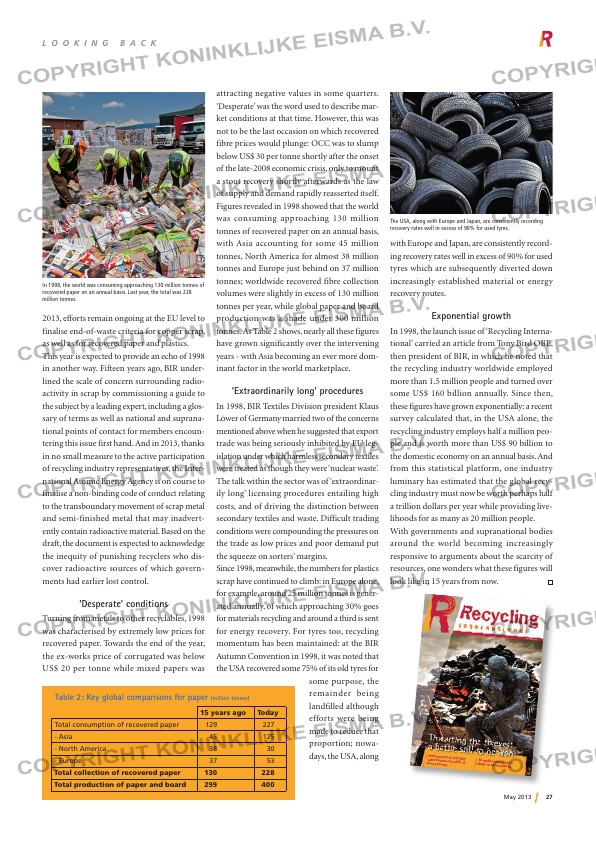Page 27 from: May 2013

27May 2013
L O O K I N G B A C K
2013, efforts remain ongoing at the EU level to
finalise end-of-waste criteria for copper scrap,
as well as for recovered paper and plastics.
This year is expected to provide an echo of 1998
in another way. Fifteen years ago, BIR under-
lined the scale of concern surrounding radio-
activity in scrap by commissioning a guide to
the subject by a leading expert, including a glos-
sary of terms as well as national and suprana-
tional points of contact for members encoun-
tering this issue first hand. And in 2013, thanks
in no small measure to the active participation
of recycling industry representatives, the Inter-
national Atomic Energy Agency is on course to
finalise a non-binding code of conduct relating
to the transboundary movement of scrap metal
and semi-finished metal that may inadvert-
ently contain radioactive material. Based on the
draft, the document is expected to acknowledge
the inequity of punishing recyclers who dis-
cover radioactive sources of which govern-
ments had earlier lost control.
‘Desperate’ conditions
Turning from metals to other recyclables, 1998
was characterised by extremely low prices for
recovered paper. Towards the end of the year,
the ex-works price of corrugated was below
US$ 20 per tonne while mixed papers was
attracting negative values in some quarters.
‘Desperate’ was the word used to describe mar-
ket conditions at that time. However, this was
not to be the last occasion on which recovered
fibre prices would plunge: OCC was to slump
below US$ 30 per tonne shortly after the onset
of the late-2008 economic crisis, only to mount
a stout recovery shortly afterwards as the law
of supply and demand rapidly reasserted itself.
Figures revealed in 1998 showed that the world
was consuming approaching 130 million
tonnes of recovered paper on an annual basis,
with Asia accounting for some 45 million
tonnes, North America for almost 38 million
tonnes and Europe just behind on 37 million
tonnes; worldwide recovered fibre collection
volumes were slightly in excess of 130 million
tonnes per year, while global paper and board
production was a shade under 300 million
tonnes. As Table 2 shows, nearly all these figures
have grown significantly over the intervening
years – with Asia becoming an ever more dom-
inant factor in the world marketplace.
‘Extraordinarily long’ procedures
In 1998, BIR Textiles Division president Klaus
Löwer of Germany married two of the concerns
mentioned above when he suggested that export
trade was being seriously inhibited by EU leg-
islation under which harmless secondary textiles
were treated as though they were ‘nuclear waste’.
The talk within the sector was of ‘extraordinar-
ily long’ licensing procedures entailing high
costs, and of driving the distinction between
secondary textiles and waste. Difficult trading
conditions were compounding the pressures on
the trade as low prices and poor demand put
the squeeze on sorters’ margins.
Since 1998, meanwhile, the numbers for plastics
scrap have continued to climb: in Europe alone,
for example, around 25 million tonnes is gener-
ated annually, of which approaching 30% goes
for materials recycling and around a third is sent
for energy recovery. For tyres too, recycling
momentum has been maintained: at the BIR
Autumn Convention in 1998, it was noted that
the USA recovered some 75% of its old tyres for
some purpose, the
remainder being
landfilled although
efforts were being
made to reduce that
proportion; nowa-
days, the USA, along
with Europe and Japan, are consistently record-
ing recovery rates well in excess of 90% for used
tyres which are subsequently diverted down
increasingly established material or energy
recovery routes.
Exponential growth
In 1998, the launch issue of ‘Recycling Interna-
tional’ carried an article from Tony Bird OBE,
then president of BIR, in which he noted that
the recycling industry worldwide employed
more than 1.5 million people and turned over
some US$ 160 billion annually. Since then,
these figures have grown exponentially: a recent
survey calculated that, in the USA alone, the
recycling industry employs half a million peo-
ple and is worth more than US$ 90 billion to
the domestic economy on an annual basis. And
from this statistical platform, one industry
luminary has estimated that the global recy-
cling industry must now be worth perhaps half
a trillion dollars per year while providing live-
lihoods for as many as 20 million people.
With governments and supranational bodies
around the world becoming increasingly
responsive to arguments about the scarcity of
resources, one wonders what these figures will
look like in 15 years from now.
Table 2: Key global comparisons for paper (million tonnes)
15 years ago Today
Total consumption of recovered paper 129 227
– Asia 45 125
– North America 38 30
– Europe 37 53
Total collection of recovered paper 130 228
Total production of paper and board 299 400
In 1998, the world was consuming approaching 130 million tonnes of
recovered paper on an annual basis. Last year, the total was 228
million tonnes.
The USA, along with Europe and Japan, are consistently recording
recovery rates well in excess of 90% for used tyres.
RI-4_Looking Back.indd 27 03-05-13 14:02



